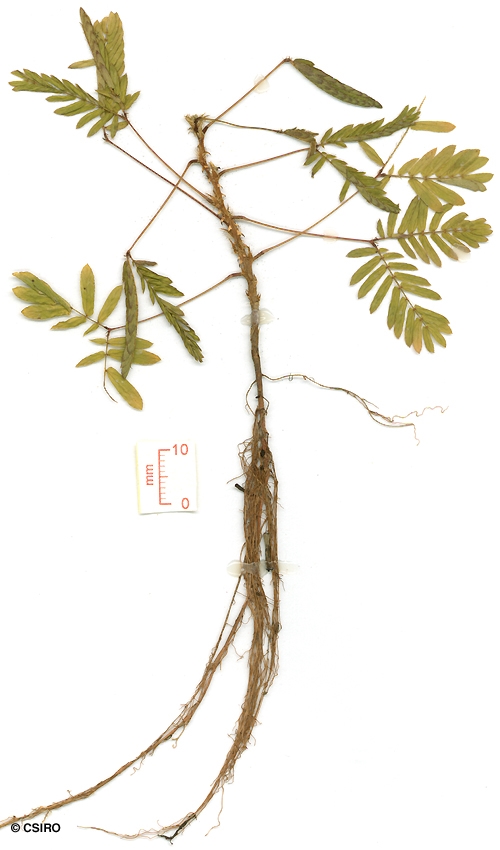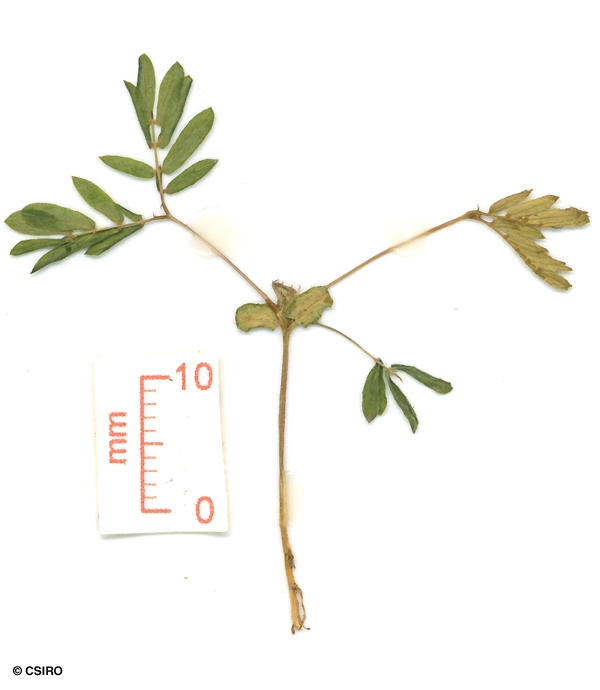Australian Tropical Rainforest Plants - Online edition
Mimosa pudica L.






Linnaeus, C. von (1753) Species Plantarum 2: 518. Type: Brazil, Herb. Cliffort.; lecto BM. Fide J. P. M. Brenan, Kew Bull. 1955: 185 (1955).
Common Sensitive Plant; Sensitive Plant; Sensitive Weed
Leaves bipinnate, each compound leaf consists of a rhachis and about 2-4 secondary axes to which about 10-26 pairs of leaflets are attached. Leaflet blades sessile or with very short swollen leaflet stalks, oblique or unequal sided at the base, about 4-15 x 1-3 mm, variously clothed in hairs on both the upper and lower surfaces. Stipules about 7 mm long, longitudinally veined, hairy on the outer but glabrous on the inner surface. Leaves sensitive, collapsing and falling downwards when touched but with the leaflets folded inwards and upwards. Twigs armed with recurved spines particularly near the point of attachment of the leaves.
Flowers borne in a spike or head about 10-13 mm long on a peduncle about 10-30 mm long. Spikes axillary, about 1-5 in each leaf axil. Calyx about 0.2 mm long, very difficult to distinguish. Corolla about 1.5-2.3 mm long, the petals fused for about half their length. Anthers about 0.3 mm long, filaments pink, about 6-8 mm long, fused together near the base. Style laterally attached to the ovary. Ovules about four per ovary.
Pods about 9-20 x 3-5 mm, flattened, constricted between the seeds, margin clothed in bristles. Pods breaking up at maturity into one seeded sections to release the seeds or dehiscing along both margins but in either event leaving the thickened margin and bristles forming a hairy spider-like structure. Seeds about 3 mm long, somewhat flattened particularly near the margin. Testa pale brown. Cotyledons +/- orbicular, much wider than the radicle.
Cotyledons about 4-6 x 3-5 mm, cotyledonary stipules present. First leaf pinnate, second leaf bipinnate. At the tenth leaf stage: stipules triangular, about 3-8 mm long, longitudinally veined. Stem clothed in curved, down-turned, black or brown-tipped spines. Leaves bipinnate with about 32 leaflets per compound leaf. Leaflets oblique at the base, sessile or with a very short swollen petiole. Leaves very sensitive, collapsing when touched. Roots emit a distinct odour when crushed perhaps resembling that of garlic (Allium sativum). Seed germination time 10 to 41 days.
An introduced species originally from South America but now a pantropic weed. naturalised in NT, CYP, NEQ, CEQ and southwards as far as south eastern New South Wales. Altitudinal range from near sea level to 300 m. Usually grows as a weed of agricultural land but also found in open forest, along roads and in disturbed areas in well developed lowland and upland rain forest.
This species has been used medicinally in India. Cribb (1981).





